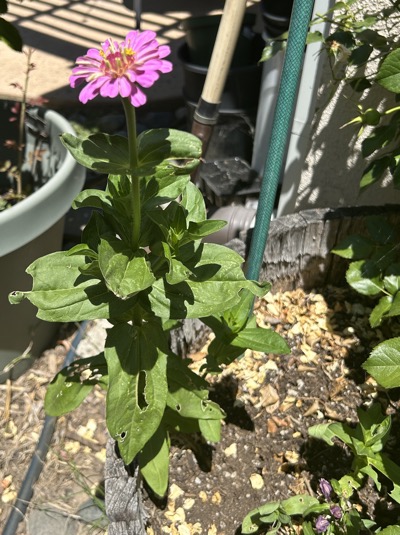
Healthy is better and it's less stressful, too

Yes, there are some holes in those melon leaves. Am I worried? No -- I'm not growing melons for their leaves. Kathy Morrison
Perfection is over-rated. It's also tough on the garden, on wildlife -- and on the gardener.
Experienced gardeners know this. We're used to the holes punched in rose foliage by leafcutter bees. We don't fly into a frenzy when the sunflower leaves are pecked by lesser goldfinches. And we know that the water spots or ragged edges or sunburn or slightly curled leaves are part of what happens as the weather changes and the plants adjust.
There is no perfection in nature, but newbie gardeners or obsessives keep trying to achieve -- or worse, maintain -- that magazine-perfect look in their backyard gardens.
Sacramento has been spoiled this year, I admit, by the mild weather through the spring. The plants look happier than ever, unstressed so far by extreme heat. My tomato plants especially are gorgeous, full of developing fruit.
I did not achieve that by spraying them with insecticide every day.
Yes, there is a gardener out there in the Sacramento area who sprays "insect killing soap" on his plants TWICE A DAY; he posted that on a Facebook gardening group that I'm a (mostly lurking) member of. This boggles the mind; never mind the fact that the package itself says "apply every 5-7 days as long as insects are present." There can't be a flying or crawling critter within half a mile of his garden by now. And he has a broad-spectrum insecticide as a "backup." Ay-yi-yi.
(By the way, spraying an infested plant with water is an excellent way to battle aphids, whiteflies, spider mites and powdery mildew. Just water.)
That same social media group has some members who fuss over every slight imperfection on leaves, who water twice a day "just in case" then wonder why a plant's leaves turn yellow, or who worry that their vegetable plants are dropping some flowers unpollinated. (It's biology, people, think about it.)

I wish more gardeners would turn to the UC Integrated Pest Management website first, for science-based solutions, before throwing a problem out on social media. ("Pest" in IPM refers to plant diseases or weeds as well as insect pests.) The California Master Gardener's Handbook sums up the approach: "A fundamental concept of IPM is that a limited amount of pest damage to plants can be tolerated."
Now, big problems should be addressed and quickly: A tomato plant that collapses overnight, for instance, or a tree that's losing its bark. In those cases, check with experts (master gardeners or arborists recommended) about diagnosis and remedy. Most instances of online "crowd diagnosis" include some really bad advice along with the good.
So back off, gardeners. If the plant is generally healthy, if you did enough prep work before planting, if you have flowers and bees and a decent irrigation setup, the garden will do well enough this summer. Slow down, stop stressing and ENJOY that garden, ragged leaves and all.
Comments
0 comments have been posted.Sacramento Digs Gardening to your inbox.
Sites We Like
Garden Checklist for week of April 21
This week there’s plenty to keep gardeners busy. With no rain in the immediate forecast, remember to irrigate any new transplants.
* Weed, weed, weed! Get them before they flower and go to seed.
* April is the last chance to plant citrus trees such as dwarf orange, lemon and kumquat. These trees also look good in landscaping and provide fresh fruit in winter.
* Smell orange blossoms? Feed citrus trees with a low dose of balanced fertilizer (such as 10-10-10) during bloom to help set fruit. Keep an eye out for ants.
* Apply slow-release fertilizer to the lawn.
* Thoroughly clean debris from the bottom of outdoor ponds or fountains.
* Spring brings a flush of rapid growth, and that means your garden is really hungry. Feed shrubs and trees with a slow-release fertilizer. Or mulch with a 1-inch layer of compost.
* Azaleas and camellias looking a little yellow? If leaves are turning yellow between the veins, give them a boost with chelated iron.
* Trim dead flowers but not leaves from spring-flowering bulbs such as daffodils and tulips. Those leaves gather energy to create next year's flowers. Also, give the bulbs a fertilizer boost after bloom.
* Pinch chrysanthemums back to 12 inches for fall flowers. Cut old stems to the ground.
* Mulch around plants to conserve moisture and control weeds.
* From seed, plant beans, beets, cantaloupes, carrots, corn, cucumbers, melons, radishes and squash.
* Plant onion sets.
* In the flower garden, plant seeds for asters, cosmos, celosia, marigolds, salvia, sunflowers and zinnias.
* Transplant petunias, zinnias, geraniums and other summer bloomers.
* Plant perennials and dahlia tubers for summer bloom.
* Mid to late April is about the last chance to plant summer bulbs, such as gladiolus and tuberous begonias.
* Transplant lettuce seedlings. Choose varieties that mature quickly such as loose leaf.